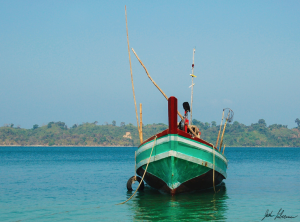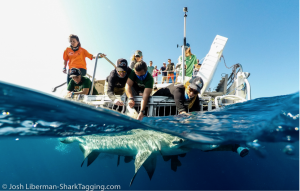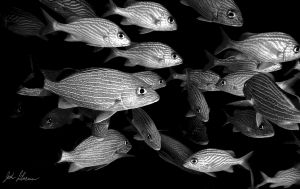Posted March 9, 2017
By KATE HOVAN
On a rickety ship off the coast of Myanmar, 15 fishermen and one American sit in the dark of night. The youngest fisherman on board is just 13 years old and the oldest is about 29. The foreigner is fascinating to the Burmese men, but their guards are still up.
Only one other American has ever joined them on their nightly excursions. They murmur and ask questions through a translator, sitting on the wooden deck of the boat, which is adorned with light bulbs illuminating the black water.
Hours pass and the moon overhead is beginning to set. Soon, fish and squid will swim toward the surface, attracted by the glow of the bulbs. The fishermen will have their catch to bring home in the morning.
Every night there is work to be done out on the open water, but from the shore, onlookers see no more than the glittering bulbs dancing along the horizon.
Josh Liberman, a 23-year-old self-taught photographer, had been just another person who peered at those lights night after night and watched broken bulbs wash up in the tide by day.
He didn’t know what was happening on the water, but he had been relentless in his quest to find out.
In retrospect, those lights encapsulate Liberman: a symbol of both his job as a photographer as well as his courage. Quite literally, Liberman stated that photography is the capturing and manipulation of light. However, the lights that night left him with something more.
“It was this moment that I was just so proud of myself for having this question and doing what I had to do to find the answer to it,” Liberman said.
Ironically enough, he has no photographs from this night, but it acts as a testament to his ambition today.
Liberman is primarily a nature photographer who is currently using his talent and bold spirit for a program known as the Shark Research and Conservation Program (SRC) at the University of Miami.
The SRC is a “joint initiative of the Rosenstiel School of Marine and Atmospheric Science and the Leonard and Jayne Abess Center for Ecosystem Science and Policy,” according to the website.
There, Liberman is able to couple his love for nature photography with his undergraduate background in biology and chemistry. He is also a recent graduate of UM.
The SRC is focused on work in science, education, conservation and technology for the study and conservation of sharks.
Liberman is both a photographer and videographer for the program, creating social media content during shark-tagging trips.
With all of his work, Liberman seeks to give a different perspective to those who are or scared of, or simply do not understand, sharks and the world beneath the waves.
“I want to show people the natural world in a way they might not have seen it before,” Liberman said. “I think the natural world has so many perfect elements in it and every animal is so perfectly adapted to their environment. I think humans have a lot to learn from that. For our every day lives we have to use so many tools just to make ourselves comfortable”
Jorge Dominicis first got to know Liberman as a roommate and friend throughout college. Liberman’s adventurous nature was obvious to Dominicis on many occasions, including a biking trip on Virginia Key. Beyond that, though, Dominicis stressed just how informed Liberman is about the subjects of his photographs.
“He studied biology and I think it’s really cool that he gets to use his creative side, and when you’re talking to him about it he can explain it all,” Dominicis said. “He knows so much about the stuff he’s taking pictures of.”
Liberman’s Instagram account is filled with photographs, boasting lengthy captions about many of the animals he encounters. The account doubles as both an artistic outlet for Liberman and an educational source for his more than 2,500 followers.
Liberman pairs most artistic shots with a more scientific description about how each animal’s unique form fits its function.
Though his background in science might seem ideal for a nature photographer, Liberman said becoming a photographer was not true aspiration for most of his life.
His family loves to travel and he had been taking photographs as early as 10 years old, but being the son of a nurse and a doctor made Liberman feel his career path was predetermined. It wasn’t until his senior year of college that photography became a genuine consideration.
“I didn’t know that this was an option,” Liberman added. “I had no idea that I could do this and survive.”
During college, Liberman studied abroad through a program called Semester at Sea. Students travel on a ship for more than three months while taking classes and visiting numerous countries across the globe. This trip, specifically, became a driving force in Liberman’s career.
Ross Nicol, a fellow photographer he met during the program, said he and Liberman quickly became best friends. The pair explored most of the 12 countries together and fed off of each other’s artistic styles, always pushing one another to improve. At the end of the trip, Nicol saw tangible evidence of the transformation that occurred in Liberman’s work.
“There were photography awards for the best shots taken in the photography course that he was in,” Nicol explained. “He won basically every award, and it was that moment that I saw it click in him that he could do photography and take it more seriously.”
But for Liberman, true fulfillment doesn’t come as a physical award. His work feels most meaningful when a new pair of eyes sees one of his photographs for the first time.
“I don’t look at the screen with them, I look at their face,” he said. “It makes me so happy when they have a similar emotional reaction that I had when I took the photo. That’s the goal for me.”
Even so, Liberman is always striving to reach a higher caliber. He knows that his work will have to stand out among a sea of both professional and amateur photographers.
“It’s easy to become a photographer if you’re given the right tools,” Liberman added. “With Instagram and instant gratification, it’s a lot harder to get somebody to give that second glance. But it’s good because there’s always this push to get a more engaging photo, a more exciting photo or a more emotional photo.”
For more information about Liberman’s work and a look at his photographs, visit www.joshliberman.com.



